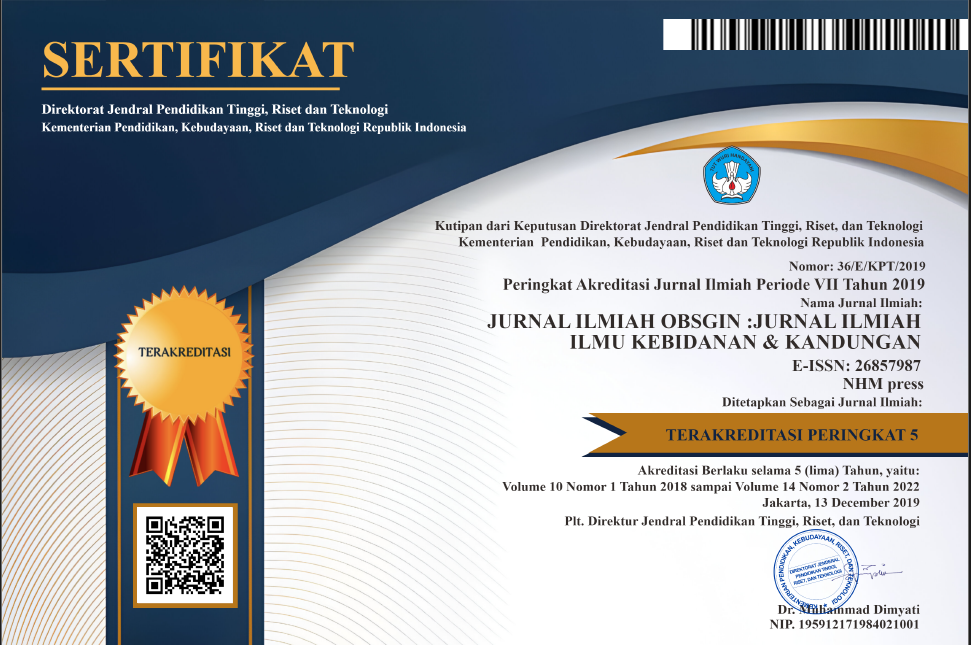RIWAYAT KEKURANGAN ENERGI KRONIS PADA KEHAMILAN SEBAGAI PREDIKTOR KEJADIAN STUNTING PADA ANAK: SISTEMATIK REVIEW
Abstract
The government is currently concerned about stunting. Stunting, often known as "short" toddler, is a failure of growth in infants caused by persistent nutritional issues, in which the baby is malnourished for 1000 days of his or her life. When they grow up, the stunting that happens will be detrimental. The goal of this research was to see if there was a link between chronic energy shortage in pregnant mothers and child stunting.
The sample of this research is mother and or child. Writing this literature review is based on research articles/journals using an observational study design; case control and cohort.
The data base involved is Google Scholar which is used as the main source of data search in writing this research. Search literature using keywords: “stunting, history of chronic energy deficiency, pregnant women. The literature/articles accessed are published in Indonesian. Screening is carried out in taking literature materials that are considered appropriate and relevant to the title being studied. The literature taken is published for the period between 2016-2021.
The results of the literature search have found a lot of literature from national and Indonesian-language journals, as many as 2,210. After screening, it was found that 1,101 articles did not have the full text because they were in the form of a repository or digital library, and could not be accessed, 310 articles had a variable scope not a history of chronic energy deficiency in pregnancy, there were 35 articles in the form of theses and theses, so that after being filtered and declared eligible, the remaining 12 articles.
References
Akhmad, A., Yadi, S., & Farma, I. (2016). Incidence of stunting and its relationship with food intake, infectious diseases, and economic status in Kendari, Southeast Sulawesi, Indonesia. Public Health Indonesia, 2(4), 177–184.
Alfarisi, R., Nurmalasari, Y., & Nabilla, S. (2019). Status gizi ibu hamil dapat menyebabkan kejadian stunting pada balita. Jurnal Kebidanan Malahayati, 5(3), 271–278.
Alifariki, L. O. (2020). Gizi Anak dan Stunting. Yogyakarta. Penerbit LeutikaPrio.
Alpin, A. (2021). Hubungan Karakteristik Ibu dengan Status Gizi Buruk Balita di Wilayah Kerja Puskesmas Tawanga Kabupaten Konawe. Nursing Care and Health Technology Journal (NCHAT), 1(2), 87–93.
Astuti, A., Muyassaroh, Y., & Ani, M. (2020). The Relationship Between Mother’s Pregnancy History and Baby’s Birth to the incidence of stunting in infants. Journal of Midwifery Science: Basic and Applied Research, 2(1), 22–26.
Kemenkes RI. (2018). Hasil utama RISKESDAS 2018. In Kementerian Kesehatan Badan Penelitian dan Pengembangan Kesehatan. https://kesmas.kemkes.go.id/assets/upload/dir_519d41d8cd98f00/files/Hasil-riskesdas-2018_1274.pdf
Lestari, W., Margawati, A., & Rahfiludin, Z. (2014). Faktor risiko stunting pada anak umur 6-24 bulan di kecamatan Penanggalan kota Subulussalam provinsi Aceh. Jurnal Gizi Indonesia (The Indonesian Journal of Nutrition). https://doi.org/10.14710/jgi.3.1.126-134
Menezes, R. C. E. de, Lira, P. I. C. de, Leal, V. S., Oliveira, J. S., Santana, S. C. da S., Sequeira, L. A. de S., Rissin, A., & Batista Filho, M. (2011). Determinants of stunting in children under five in Pernambuco, Northeastern Brazil. Revista de Saude Publica, 45, 1079–1087.
Muldiasman, M., Kusharisupeni, K., Laksminingsih, E., & Besral, B. (2018). Can early initiation to breastfeeding prevent stunting in 6–59 months old children? Journal of Health Research.
Rahayu, S. (2020). Determinant Analysis Of Stunting Events In Toddlers Aged 6-24 Months Judging From The Nutritional Status Of Pregnant Women, Birth Weight And Eksklusive Breast Feeding At Garum Health Center. European Journal of Molecular & Clinical Medicine, 7(2), 4733–4742.
Rangki, Alifariki L.O, H., Rahmawati, R., & Sukurni, Salma, W. . (2020). Risk Factors of Stunting in Children Age 24-59 Months Old. Media Keperawatan Indonesia, 3(1), 10–16.
Stewart, C. P., Iannotti, L., Dewey, K. G., Michaelsen, K. F., & Onyango, A. W. (2013). Contextualising complementary feeding in a broader framework for stunting prevention. Maternal and Child Nutrition, 9(S2), 27–45. https://doi.org/10.1111/mcn.12088
Ulfa, M. P. R., & Almira, S. (2019). Status Ekonomi Orang Tua Dan Ketahanan Pangan Keluarga Terhadap Kejadian Stunting Pada Balita Di Kabupaten Gunungkidul. Poltekkes Kemenkes Yogyakarta.
Warsini, K. T., Hadi, H., & Nurdiati, D. S. (2016). Riwayat KEK dan anemia pada ibu hamil tidak berhubungan dengan kejadian stunting pada anak usia 6-23 bulan di Kecamatan Sedayu, Bantul, Yogyakarta. Jurnal Gizi Dan Dietetik Indonesia (Indonesian Journal of Nutrition and Dietetics), 4(1), 29–40.
Widiastity, W., & Harleli, H. (2021). Hubungan Pemberian MP-ASI Terhadap Kejadian Stunting Pada Balita Usia 6–24 Bulan di Puskesmas Soropia. Nursing Care and Health Technology Journal (NCHAT), 1(2), 81–86.
Widyawati, S.A, Wahyuni, S. (2021). Factors Related to Stunting Events in Children. Annals of the Romanian Society for Cell Biology, 25(6), 3324–3332.
Zaif, R. M., Wijaya, M., & Hilmanto, D. (2017). Hubungan antara Riwayat Status Gizi Ibu Masa Keha milan dengan Pertumbuhan Anak Balita di Kecamatan Soreang Kabupaten Bandung. Jurnal Sistem Kesehatan, 2(3).











